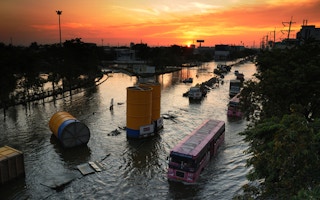Asia’s fast-growing cities are struggling to build the roads, waste management and drinking water systems that could help protect their swelling populations from climate-related disasters, said city leaders from across the region.
Many of these cities are in disaster-prone coastal areas, river deltas and floodplains. Experts estimate that by 2030, 55 per cent of the 3.7 billion people in developing Asian nations will be living in cities.
“Asia-Pacific is the region of the world most affected by the impacts of climate change,” Bangkok Deputy Governor Pusadee Tamthai told a forum on urban resilience.
“This is because this is the fastest-growth region, with a lack of urban planning to accommodate the cities’ expansion and especially the environmental problems.”
About 300 city officials, development experts and researchers from 100 cities in 30 countries in Asia, North America and Europe convened in Bangkok for the three-day conference that ends on Friday.
“
Asia-Pacific is the region of the world most affected by the impacts of climate change…This is because this is the fastest-growth region, with a lack of urban planning to accommodate the cities’ expansion and especially the environmental problems.
Bangkok Deputy Governor Pusadee Tamthai
Asia-Pacific is the region most affected by disasters, with 714,000 deaths from natural disasters between 2004 and 2013, more than treble the previous decade, and economic losses topping $560 billion, according to the United Nations.
“The Asia-Pacific region is also in the midst of the largest and most consequential urban transformation in history,” said Shunichi Murata, deputy executive secretary of the UN’s development arm for the region.
He noted that 2.1 billion people live in the region’s cities and towns, making up more than half of the world’s urban population.
“These numbers are poised to increase as the region further urbanises,” said Murata. “Many of these cities and towns lie in highly vulnerable areas.”
It was “sobering” to note that eight out of the 12 largest disasters impacting cities between 2000 and 2010 happened in Asia and the Pacific, he added.
Deputy city governor Pusadee said Bangkok was expanding its mass transit rail system to reduce traffic congestion in the centre, while also promoting cycling with 50 bike-sharing stations around the city.
Bangkok was also teaming up with the private sector to build a waste-to-energy plant that would process 300 to 500 tonnes of waste per day, said Supachai Tantikom, advisor to the governor.
The city produces about 9,000 tonnes of waste daily, 90 per cent of which goes to landfills in nearby provinces, Supachai said.
In Bhutan, the capital Thimphu has sprawled to the size of 26 sq km, from only 8 sq km in 2002, and its population has grown to 130,000 from 85,000 a decade ago, said city mayor Kinlay Dorjee.
While Thimphu, a city in the mountains, does not face flooding like larger low-lying cities in the region, climate change has impacted water availability, he said.
“We have glaciers melting… and the issue of not having adequate water in the river because of increasing temperatures and heat,” Dorjee said.
Thimphu had previously taken most of its water from small streams, but with these now suffering water shortages, the city has had to “tap the main river” for its water supply, he said.
“Our water sources are drying up,” he added.








